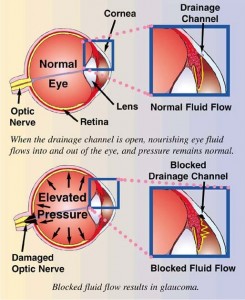Do you think you will know if you have glaucoma?
 The first symptom of the most common type of glaucoma (open angle) is permanent loss of vision. Once vision loss occurs it is downhill, the damage from glaucoma is irreversible and challenging to slow down.
The first symptom of the most common type of glaucoma (open angle) is permanent loss of vision. Once vision loss occurs it is downhill, the damage from glaucoma is irreversible and challenging to slow down.
Glaucoma signs include increase intra-ocular pressure (IOP) which is measured during an eye exam. Visual field loss, also measured during an eye examination and loss of retinal nerve fibers and damage to the optic nerve, visible during a dilated eye examination. The best way to determine if you have or are at risk of glaucoma is by having a dilated eye examination.
What is Glaucoma?
Glaucoma is a disease of the optic nerve usually caused by increased pressure inside the eye.
Glaucoma Risk Factors:
Age – greater than 60
Diabetes
Race – African American have higher risk
Treatment
Glaucoma is treated with drops or surgery and sometimes both.
Don’t wait until you have vision loss to learn that you have glaucoma, schedule an eye exam today.
